- Park Guell
- Dragon
- Park Guell Monumental Zone
- History
- Architecture
- Inside
- Antoni Gaudi
- Parking
- UNESCO World Heritage Site
- Nature and Biodiversity
- Plan Your Visit
- Skip the Line Tours
- Guided Tours
- Timings
- Directions
- Rules
- Entrances
- Facts
- Tips
- Map
- Audio Guide
- Free Entry For Locals
- Sagrada Familia
- Barcelona Flamenco Show Tickets
- Camp Nou Tours
- Casa Batllo
- Casa Mila
- Portaventura World
- Casa Vicens
- Hola Barcelona Travel Card
- Wax Museum Barcelona
- Las Golondrinas Barcelona
- Palau De La Musica Catalana
- Erotic Museum of Barcelona
- Barcelona Catedral
- Montserrat Monastery
- Barcelona Zoo
- KBr Photography Center Mapfre Foundation
- Big Fun Museum
- Barcelona Aquarium
All You Need to Know About Park Guell in Barcelona
Set on Carmel Hill, Park Guell is an architectural masterpiece in Barcelona. Designed by renowned architect Antoni Gaudi, this UNESCO World Heritage Site is a reflection of his unique style and love for nature. With colorful mosaic-covered buildin...
Founded On
1926
Founded By
Antoni Gaudí

Quick information
ADDRESS
08024 Barcelona, Spain
RECOMMENDED DURATION
2 hours
Timings
9:30 AM - 7:30 PM
VISITORS PER YEAR
12000000
TICKETS
From € 12.90
NUMBER OF ENTRANCES
3
EXPECTED WAIT TIME - STANDARD
30-60 mins (Peak), 0-30 mins (Off Peak)
EXPECTED WAIT TIME - SKIP THE LINE
0-30 mins (Peak), 0-30 mins (Off Peak)
UNESCO YEAR
1984
Fun facts
Park Guell was originally envisioned as a housing development project, but it failed to attract buyers and was eventually transformed into a park.
The colorful mosaics on Park Guell's iconic Dragon Stairway were crafted using the trencadís technique, which involves breaking up tiles and reassembling them to create intricate patterns.
Gaudí House Museum, designed by Francesc Berenguer, showcases Antoni Gaudí's furniture and personal belongings, providing insight into the life and work of the renowned architect.
Book Park Guell Tickets & Tours
Plan Your Visit To Park Guell

Where is Park Guell Located?
Address: 08024, Barcelona, Spain
Park Guell is located between the neighborhoods of El Coll, La Salut, Vallcarca i els Penitents, El Carmel and Can Baró, in the districts of Gràcia and Horta-Guinardó. It is spread across the two hills of Les Menes and El Carmel.
The surrounding areas are urban neighborhoods that are highly populated. The green park, therefore, offers a respite from the concrete jungle, easing urban pressure and improving the area's environmental quality.
Know More
Park Guell Opening Hours
Park Guell is open daily. The opening hours are:
From 1 July to 31 August 2022: 9 AM to 7:30 PM
From 1 September to 29 October 2022: 9:30 AM to 7:30 PM
30 October 2022 to 31 December 2022: 9:30 AM to 5:30 PM
Opening Hours for Residents
Citizens are free to come to the Park Güell, at no cost, at any time between 7 AM to 10 PM. However, to avoid crowds it might be best to visit the park from 7 AM to 9 AM and from 6 PM to 10 PM when Park Guell is reserved exclusively for residents of neighboring areas. Tourist visits are not allowed during these hours.
Know MoreZones of Park Guell
The park is divided into two zones:

Monumental Zone
The monumental zone spread over 12 hectares is the core attraction of the landmark. It includes a series of tremendous buildings.
Know More
Forest Zone
The adjacent woodland zone is spread over another 8 hectares. The woodland zone is open for everyone to visit and doesn’t require a ticket.
Things to See at Park Guell Barcelona
Park Guell is a magic wonderland created by Antoni Gaudi. Here are some of the things to look out for inside Park Guell.
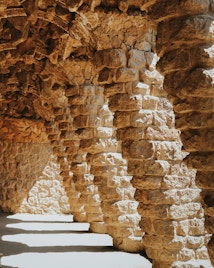
Pathways And Viaducts
Gaudi designed Park Güell with the idea of merging it with the natural surroundings and hilly topography. To achieve this, he laid down an intricate network of paths, bridges, and viaducts throughout the property. The three viaducts that glide up the mountain in succession are called Pont de Baix, the Pont del Mig, and the Pont de Dalt.
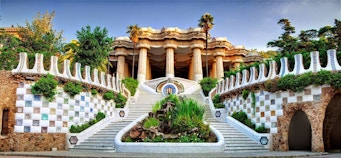
Porter's Lodge Pavilion
The main entrance to Park Güell has an impressive facade and presents a stunning view of the work of art inside. The ceramic tiled stone wall and palm leaf-shaped iron gates are just a trailer of the nature-inspired architectural marvels, one would witness ahead.
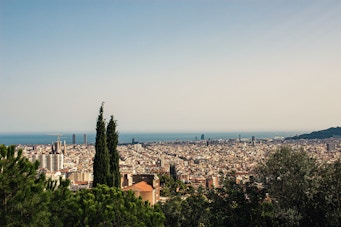
Three Cross Hill
The Three Cross Hill is the highest viewpoint in Park Guell and offers beautiful views of the city of Barcelona. Getting to the top will require some effort, as there is steep stairway to climb, but the breathtaking views at the top of the hill make the journey well worth the effort.
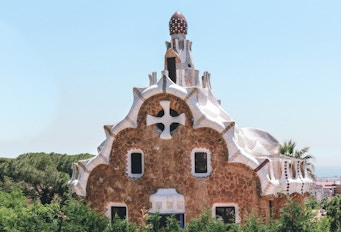
Gaudi House Museum
One of the original homes in the park, Gaudi House Museum is now a collection of the fabled architect's life and work. To enter the museum, you'll need to buy a separate ticket from the Park Guell website since the regular tour does not cover the museum.
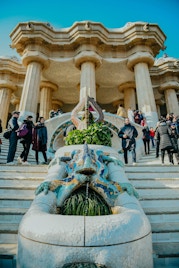
The Dragon Stairway
An artistic twin flight of steps rises up from the entrance to the Hypostyle Room. Divided into three sections, the stairway has a fountain running along its edge and each landing on the way up is marked by a distinct element.
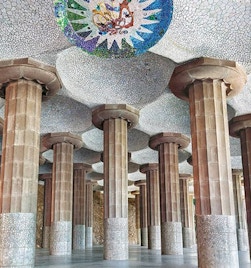
The Hypostyle Room
The Dragon Stairway culminates into an enormous space called the Hypostyle room. The entire space is supported by 86 striped columns, with the outermost ones sloping in an undulating form contrary to the rules of classical composition.

Greek Theatre
At the heart of Park Güell lies the huge open air space originally called the Greek Theatre and now called Plaça de la Natura (Nature Square). This vast platform was planned to stage large open-air shows.

Austria Gardens
With trees donated from Austria, this part of the park has a very distinguished look. The Austria gardens have a beautiful view and host two prominent houses, one of which was acquired by Gaudi’s family which has now been converted into Gaudí House museum.
Who Designed Park Guell?

Antoni Gaudi I cornet, one of the most significant visual artists of the 19th and 20th centuries from Spain, developed Park Guell. He is known as a pioneer of the artistic technique Art Nouveau which is also his signature art style.
Renowned for his intricate craftwork in buildings all across Spain, Gaudí's works have a highly individualized, sui generis style. Most of these buildings are located in Barcelona, including his glorious masterpiece, the church of the Sagrada Família.
During his studies, Gaudí constructed several projects, among which the following stand out: a cemetery gate (1875), a Spanish pavilion for the Philadelphia World Fair of 1876, a quay-side building (1876), and a university assembly hall (1877).
UNESCO World Heritage Site

In 1984, UNESCO declared Park Guell as a World Heritage Site as part of “The Works of Antoni Gaudi”, which features seven buildings by the architect Antoni Gaudí located in Barcelona and its surrounding areas.
The other six creations of Gaudi included in the World Heritage List includes the Palau Güell, the Casa Milà-La Pedrera, the Casa Vicens, the Nativity Façade and the Crypt of the Sagrada Família, the Casa Batlló, and the Crypt of the Colònia Güell.
Know MoreFrequently Asked Questions About Park Guell in Barcelona
Park Guell is an urban park in Barcelona, Spain that was designed by Antoni Gaudi.
Park Guell is Barcelona's landmark park. It is the second most-visited park in Barcelona after Parc de la Ciutadella, and resonates with Modernist elements like no other place. Park Guell is a must-visit in Barcelona thanks to its rich history and the mastermind behind its design, the eminent architect Antoni Gaudi.
Yes, it is perfectly safe to visit Park Guell Barcelona, as a number of health measures are in place to ensure safety of visitors.
Park Guell tickets start at €10 for adults, while guided tours start at €27.
Park Guell Barcelona has a number of highlights such as The Dragon Stairway, The Serpentine Bench, Austria Gardens, El Drac, and Laundry Room Portico, among others.
Park Guell was designed by legendary architect Antoni Gaudi, who is also the mastermind behind Casa Batllo, Casa Mila, and Casa Vicens.
Park Guell was planned and designed by Antoni Gaudi (1852-1926), between 1900 and 1914. His original designs were altered due to financial reasons, and the park opened in 1926, ten years after his death.
Park Guell is located between the neighborhoods of El Coll, La Vallcarca, El Carmel and La Floresta in Barcelona.
You can get to Park Guell in Barcelona via metro, bus, or car.
Park Guell is currently open from 9 AM to 7:30 PM.
Park Guell has three entrances — the main entrance, Carretera del Carmel, and Av. del Santuari de St. Josep de la Muntanya.
From October 2013, Barcelona City Council began regulating entry to the main core of the park with the objective of preserving the iconic space and keeping it in the best possible state of conservation. For a number of year prior, unregulated entry had begun to take its toll on the surroundings, the flora of the park and contributed to degradation of Gaudi's sculpture. In order to avoid worsening of the situation, visitor tickets are being regulated.



